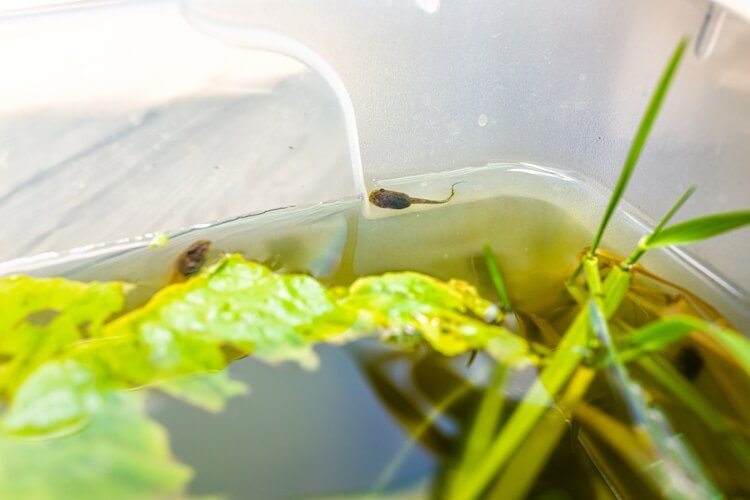
The chances are that at some point in your life you have tried to raise tadpoles.
Tadpoles are the larval stage of a frog; they are what first hatches from frog eggs. They later grow legs, lose their tails, and become frogs.
Many people think that tadpoles eat the same food as a frog, but this is not true.
They are too small to eat the same foods as frogs. They are also in water and not on land, so their diet is usually made up of aquatic plant matter.
In this article, we cover what tadpoles eat in the wild and how to feed them. We also cover what foods they can eat and what is not safe to feed them. Keep reading to make sure your hatchling is on the proper diet…
What Do Tadpoles Eat?
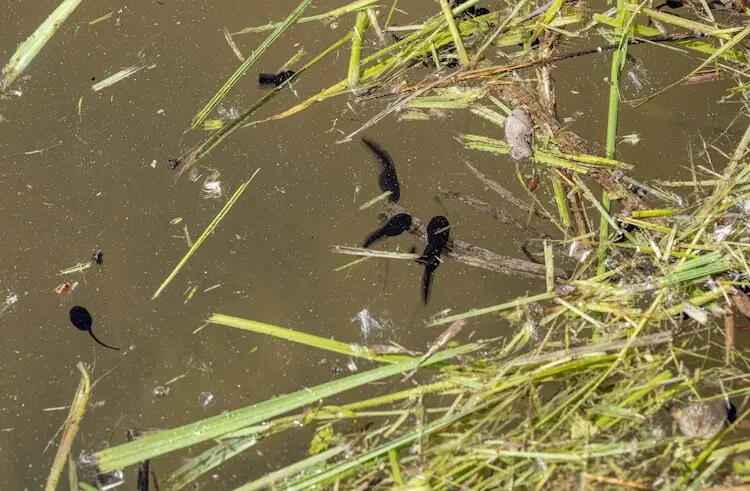
In general Tadpoles are herbivorous and eat soft plant matter like algae, duckweed and moss. Their diet can vary from species to species. But, the most common species in the United States eat soft plant matter (e.g. tree frog and bullfrog tadpoles).
They must feed multiple times a day to get the proper nutrition to continue growing at a quick rate.
Tadpoles in the wild eat algae and other aquatic plant matter multiple times a day.
This is because they can only survive in water. When they hatch, they have gills and cannot survive out of the water.
When they first hatch, they usually eat the yolk that is left from their own egg. This yolk is high in nutrients. They will usually then find cover under some type of aquatic plant, such as duckweed or lily pads, which will also serve as a food source for them.
Young tadpoles will usually not go far away from cover.
They are very vulnerable to predators during their first few months.
If plant matter such as algae or duckweed is readily available, they will eat this before hunting. Younger individuals prefer to eat anything and everything near them.
If they need to hunt, they will do so by quickly snatching anything small enough to fit in their mouths as it swims near them. They will usually only hunt small prey like mosquito larvae or small redworms.
Tadpoles only eat meat when aquatic vegetation is limited. Because they sometimes eat meat, they can technically be classified as omnivorous, but most begin as herbivores.
Wild Tadpoles
Wild tadpoles will eat whatever is available. This usually includes whatever remains of their egg, algae and the leaves or roots of any aquatic plants. Some of their favorite plants include duckweed and mosses.
Tadpoles will also eat frog eggs, mosquito larvae, bugs, and the carcasses of any dead animals in the water. If food is limited, and they are desperate, they will even eat each other.
They must consume a lot of food, so they are not picky eaters.
Here is a more detailed list of foods tadpoles eat in the wild:
- Their own eggs
- Algae
- Duckweed
- Mosses
- Detritus
- Bacteria
- Protozoa
- Mosquito larvae
- Redworms
- Water striders
- Carcasses in the water
- Fish eggs
- Frog eggs
Pond Species
The diet of a pond species will not be much different from tadpoles born in other water sources, such as the shallow ends of streams or creeks with slow currents.
The only difference is that pond species will have less variety in their diet.
Ponds have a much more limited amount of plant matter and space, so tadpoles are more likely to eat meat.
Tadpoles that hatch in ponds have a diet that consists largely of algae and mosquito larvae. If the pond is stocked with fish, they will also eat fish eggs, any dead fish that are in the pond, frog eggs, and sometimes, their pond-mates (i.e. each other).
Studies have shown that tadpoles only resort to cannibalism when resources are very limited. It makes sense that this would occur more in smaller bodies of water like ponds.
Pet Tadpoles
Pet tadpoles can eat a variety of different foods, but it is best to stick to a mostly herbivorous diet.
Some of the best foods for pet species are boiled cabbage or lettuce. Both vegetables contain calcium and protein that help a tadpole grow legs. However, make sure to avoid feeding romaine or iceberg lettuce. Neither of these varieties contain many nutrients.
Boiling finely chopped vegetables makes them softer and easier to eat.
Other foods you can feed include:
- Broccoli
- Baby Spinach
- Green Peas
- Zucchini
- Egg Yolks
- Tadpole Food
- Algae Wafers
Leafy greens that are rich in calcium and protein are best for feeding.
If you decide to go with pet store tadpole food, be sure you pick the correct kind. It should be labeled as either early (6 weeks or younger) or late-stage (6+ weeks).
Late-stage food is higher in protein and is likely to contain more animal matter. A mostly herbivorous diet is the healthiest option for your pet. Tadpoles only eat meat in the wild if they must.
Some people like to feed their tadpoles a bloodworm as a treat, but if your pet is under six weeks old, do not do this. Bloodworms are best for feeding individuals that are six weeks or older.
When feeding your tadpole, you should feed a pinch of food at a time. Offer food for about 30 minutes, or until they stop eating, whichever comes first.
Hatchlings
Baby tadpoles are limited in what they can eat. As new hatchlings, they are usually very small and cannot fit much into their mouths. Their diet will consist mostly of their own egg as well as algae. Algae is soft and easy for them to find.
During a tadpoles first 24 to 48 hours their egg yolk provides them with enough nutrition. After that, they will begin eating algae and other soft plant matter.
Hatchlings will also eat any organic matter (e.g. detritus, gravel and silt).
Whatever they eat, they will eat constantly. They have a very high metabolism and grow quickly. Growing big as fast as possible is necessary for survival, as they are an easy meal for most predators
As they grow their intestine will gradually shorten to accommodate a carnivorous diet, since meat is easier to digest
Baby tadpoles are less interested in meat than later-stage individuals.
Hatchlings have long, coiled intestines, which helps them to digest plant matter. Plants contain cellulose, a compound that is very hard to digest. Because of this, plant matter needs to spend more time in the digestive system. This long intestine gives a herbivore more time to break down the plant and absorb as many nutrients as possible.
Now that you know the basics of what tadpoles eat, let’s discuss how and when to feed them.
What To Feed Tadpoles?
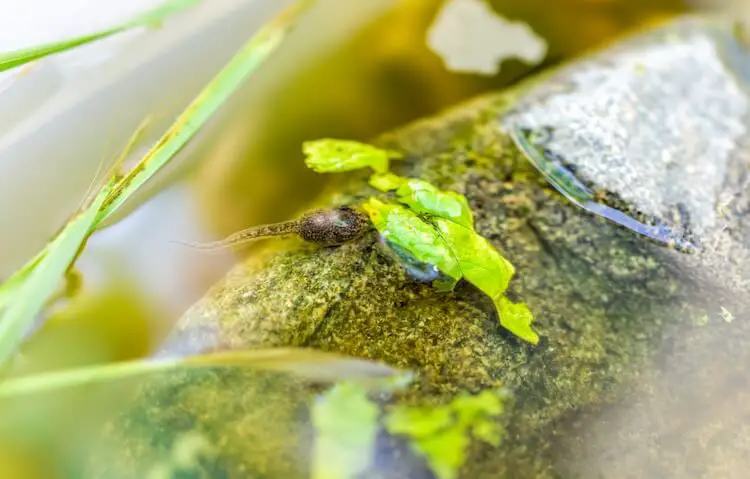
The diet of a tadpole will vary based on if it is early-stage (6 weeks or younger) or late-stage (6 to 14 weeks). Early-stage individuals should be fed herbivorous diet. You can feed them boiled and chopped vegetables such as:
- Cabbage
- Broccoli
- Lettuce
- Baby Spinach
- Green Peas
- Zucchini
You should not feed pets food from the wild (e.g. wild algae). Pet species often have weaker immune systems, as they are not exposed to the same illnesses. Feeding a pet wild-caught food risks introducing parasites and diseases.
As your tadpole grows you can add more protein into their diet by feeding bloodworms and late-stage food from the pet store. However, this should be done only after six weeks.
Preparing, chopping and boiling vegetables will help to make sure your tadpole can easily eat.
Start by boiling and finely chopping their food.
Using a pair of tweezers or just your fingers, you can put a pinch of food into the water.
After the tadpole has consumed the first pinch offered, repeat this. Feed your tadpole until it stops eating. They are usually good and will not overeat, but to be safe, make sure each feeding session lasts no more than 30 minutes.
It is important to use a net to remove any uneaten food.
Uneaten food left in the tank can foul the water, which can be very stressful for them. It will also mean you will need to cycle the water more frequently.
Another important thing to remember when feeding is to rotate what the variety of their diet.. They need some variation to help ensure they get all the nutrients they need. Many keepers find it useful to create a feeding schedule.
Feeding schedules also allow you to figure out if your tadpole prefers a specific type of food. This is useful to know if it becomes ill and you need to coax it to eat.
Here is an example of a feeding schedule you can use:
| Day | Food |
|---|---|
| Monday | Boiled cabbage, boiled baby spinach. |
| Tuesday | Boiled kale, boiled cucumber with seeds removed. |
| Wednesday | Algae wafers, boiled baby carrot. |
| Thursday | Boiled broccoli, boiled leeks. |
| Friday | Boiled cabbage, boiled zucchini. |
| Saturday | Boiled green peas, a few pinches of tadpole food. |
| Sunday | Boiled kale, boiled broccoli. |
If you have wild tadpoles in a pond then you really will not need to feed them.
If your pond is small, clear of algae, or manmade, you can feed algae wafers from a pet store. You should also add plants such as duckweed and lily pads. These aquatic plants provide both food and shelter.
You should not treat pond water to prevent algae growth. Algae is one of the biggest parts of a wild tadpole’s diet.
Wild species are also likely to be just fine on their own. You should only offer algae wafers if it is obvious that they do not have access to enough food. It is best not to feed wild species; this rule applies to most wildlife.
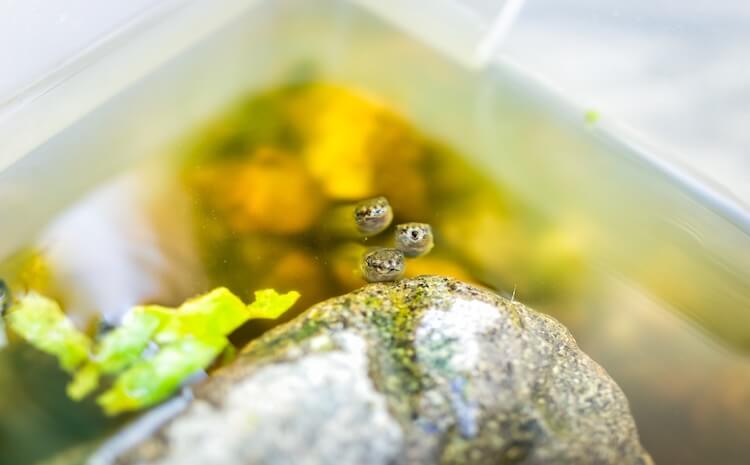
What Can’t Tadpoles Eat?
You should only be feeding your tadpoles dark leafy greens, blanched/boiled vegetables, algae wafers or insect larvae.
Until now we have not really discussed foods you should avoid.
To help you out, we have compiled a list of foods you should not feed tadpoles:
- Meat – they have a digestive tract meant for plant matter, not meat.
- Processed human foods – chemicals and seasonings in human foods can kill them.
- Bread – this has no nutritional value.
- Fish food – you should avoid it unless it is an emergency and fish food is all you have.
- Dog food – it contains grains that they cannot digest.
- Cat food – it contains grains that they cannot digest.
- Fruit – it contains too many sugars to be fed as a main part of the diet.
Can Tadpoles Eat
Algae Wafers: Yes. Algae wafers are the closest food you can find to a natural diet for tadpoles. They contain a lot of good nutrients that will help keep them happy and healthy. Just be sure to only feed little bits at a time, any uneaten food will cause the water to become foul.
Bread or Bread Crumbs: No. Bread has absolutely no nutritional value. Also, their digestive systems are not made to process bread. Bread crumbs can contain chemicals that are bad for tadpoles. Really, no aquatic animals should be fed bread. It will likely do more harm than good.
Cucumber: Yes! Cucumbers are perfectly fine to feed. In addition to boiling them until soft, you also need to remove the seeds and chop them into tiny pieces. If you do these three things, cucumbers can become a tasty and nutritious part of their diet.
Dog Food: No, dog food should not be fed. It often contains grains and excessive amounts of protein. Dog food is probably a little better than bread crumbs, but it is still best to avoid it.
Fish Food: Tadpoles can eat fish food, but this should only be fed as a last resort if you cannot get your tadpoles to eat anything else. Feeding fish food will make them less prepared for a more natural diet. Overfeeding fish food can shorten their lifespan, as it is not formulated for their dietary needs. If you do decide to feed fish food, you are better off feeding flakes than pellets.
Spinach: Absolutely. Spinach is a very nutritious green that is pretty similar to what a tadpole will eat in the wild. Make sure to wash it thoroughly to remove any dirt or parasites. After washing, you will want to boil it until soft, and then feed it in small pieces.
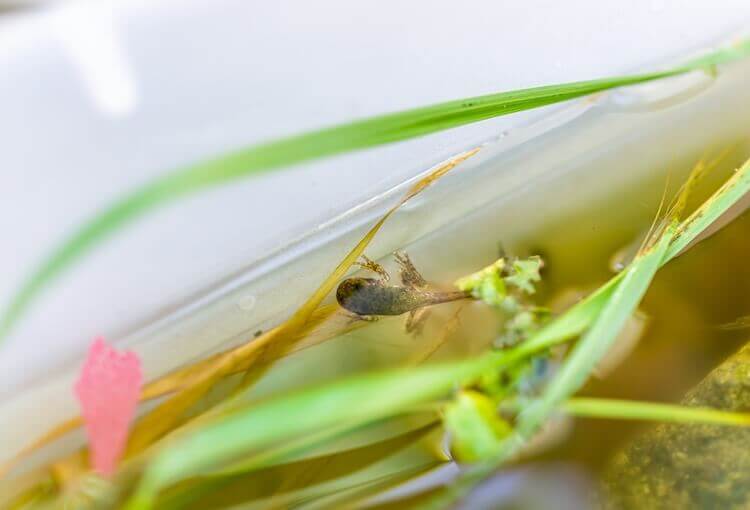
Summary
You can now consider yourself an expert in both pet and wild tadpoles’ diets!
Tadpoles eat their own eggs, algae, the leaves and roots of aquatic plants, insect larvae and dark leafy greens.
Generally, you should feed pet tadpoles boiled and chopped vegetables such as cabbage, baby spinach, or cucumbers once a day. Feed a pinch of food at a time until either they refuse to eat or until the feeding session has gone on for 30 minutes.
You should make sure not to feed tadpoles human food, bread, food made for other pets, wild-caught bugs or meat.
We hope this guide helps you to feed and raise your tadpoles. Let us know in the comments if you found it helpful.

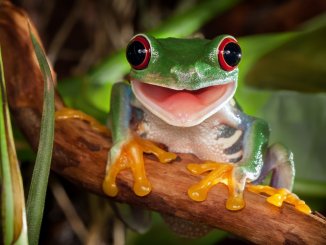
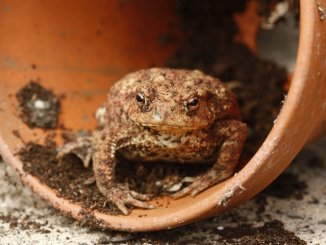
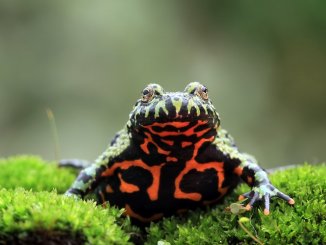

Very enlightening; I am now on the right path, and avoiding mistakes. Bonus: very much looking forward to seeing these mosquito larvae devoured.
P.S. Why are amphibians featured on a Reptile webpage?
I think because a lot of reptile owners look into amphibians. I own a lizard and im looking into tadpoles or salamanders
also I want to know why spiders and scorpions are featured. Frogs are closer to reptiles in looks. Arachnids are not
As our audience grows, so does our reach. I find arachnids fascinating creatures so I decided to include them.
What about canned spinach? I’m in a pinch and am trying to find something to feed them until I can get out to the store.
Ⓣⓗⓐⓝⓚ 🅈🄾🅄 this helps alot. I was wondering if you could feed the grass roots but if not plz tell me. Thx🐸
They most certainly eat the roots of aquatic plants, but we do not have precise or trustworthy information for grass roots.
Thanks, this is very helpful. I want to own some tadpoles and now I know ho to
Very heplful
Very helpful. I really want to try to raise tadpoles and as Sam Ingrosaw said above as well, now I am on the right track and avoiding mistakes. Thanks
In the past two weeks I have had what I believe to be green frog and gray tree frogs deposit their eggs and my dog’s wading pool. I would like to release these somewhere but I’m not sure how to find the appropriate place. I do not believe there are water sources near me other than drainage ditches and Retention Ponds. Do you have any suggestions? I am in metro Atlanta Georgia.
Theoretically, if the frog got there it means there is some sort of at least mildly habitable space near your house. Generally speaking, without going into interspecies differences, I would suggest any body of water (even a small one) that is not going to dry up in the summer months. Tadpoles will adapt to the ditches and ponds you mentioned, despite their potentially dangerous levels of pollution. You could transfer them to a larger bucket that you periodically fill with some water to see them grow, but if this is not what you are looking for, you can release them in slow moving or still waters that seem to be quite stable over the summer months. Again, there might be an insignificant one next to your house that you have perhaps never noticed but that is ultimately the place where the parent frog came from. A larger body of water might seem appropriate but this will expose the eggs to predation from larger animals that on the contrary, you wouldn’t find in a small pool